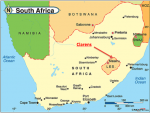 Examples of Good Practice
Examples of Good Practice
In the last section in my book The Poor deserve the Best (see side panel) I have included reports from various development ‘sectors’ to illustrate good practice and to give key considerations for others who may be considering starting a ministry in the same sector.
This and the next posting was included in the Education sector. Margaret Grant, Founder and Principal of Dihlabeng Christian School in the Free State, South Africa, shares from her own experience.
The Vision
Dihlabeng Christian School was started in January 2000 as a part of Dihlabeng Christian Church’s desire to bring hope to the hopeless by working with the materially disadvantaged and those from the poorer part of the community.
The school aims to provide children with an excellent primary school education. It is intentionally multi-cultural and seeks to educate children for life and godliness so that they grow into confident, life-loving adults. Looking to the future, the vision is for growing numbers of children and a staff from many different nations working together in a strong multi-cultural team.
By providing a well-rounded and stimulating education, the school is giving hope for the future and a fair chance in tomorrow’s job market for today’s children. In this way the school is helping to break down the hold that poverty and disadvantage have over many families. The school, together with the church, also provides an environment in which children can meet Jesus Christ and develop a personal relationship with Him.
Growth and Development of the School
 The school is located in the small town of Clarens, on South Africa’s northern border with Lesotho. It began with just seven Basotho children in the garage of a private home until a house in the local township was obtained. The school grew steadily in 2000 and at the end of the year had nineteen children. Growth continued and a larger building became necessary. In July 2001 the school was moved to a local municipal farm in Clarens, which gave space for future expansion. By 2008 the school had grown to more than 100 children with staff from both Basotho and English cultures. The school now has over 120 children on its attendance register and eighteen members of staff.
The school is located in the small town of Clarens, on South Africa’s northern border with Lesotho. It began with just seven Basotho children in the garage of a private home until a house in the local township was obtained. The school grew steadily in 2000 and at the end of the year had nineteen children. Growth continued and a larger building became necessary. In July 2001 the school was moved to a local municipal farm in Clarens, which gave space for future expansion. By 2008 the school had grown to more than 100 children with staff from both Basotho and English cultures. The school now has over 120 children on its attendance register and eighteen members of staff.
 Dihlabeng Christian School has developed as part of Dihlabeng Christian Church’s belief that it is God’s plan to use His church to change individual lives and thus nations and so display His wisdom and glory. The church is an integral part of all that happens at the school and vice versa. The Chairman of the School Governing Body is the lead elder at the church and other elders whose children attend Dihlabeng School are also members of the School Governing Body. The most vulnerable children who attend the school are referred to the church’s project ‘Mapheo’ which helps and supports the most needy youngsters. Likewise, children from ‘Mapheo’ who are due to start school are offered places at the school and sponsorship is sought for them.
Dihlabeng Christian School has developed as part of Dihlabeng Christian Church’s belief that it is God’s plan to use His church to change individual lives and thus nations and so display His wisdom and glory. The church is an integral part of all that happens at the school and vice versa. The Chairman of the School Governing Body is the lead elder at the church and other elders whose children attend Dihlabeng School are also members of the School Governing Body. The most vulnerable children who attend the school are referred to the church’s project ‘Mapheo’ which helps and supports the most needy youngsters. Likewise, children from ‘Mapheo’ who are due to start school are offered places at the school and sponsorship is sought for them.
Dihlabeng Christian School follows the South African national curriculum but uses a theme-based approach and all lessons are taught in a hands-on way to ensure that children fully understand what they are learning. We want all the glory to go to God through what He achieves at the school. It is our prayer that we will see people changed by His love and that the fruit of that will be seen in the lives and future of the children.
Teacher Training
The school is committed to the training of teaching staff. This is a real need and necessity. Teacher training takes place whilst staff are working. We aim to provide funds for college fees and expenses through sponsorship and small bursaries.
Next time
In the second part Margaret will report on some of the fruit of the ministry and will address the issue of funding. She will also share some of the lessons learnt.
